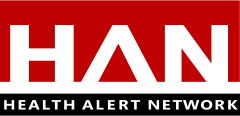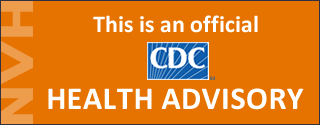Limited Availability of Nirsevimab in the United States—Interim CDC Recommendations to Protect Infants from Respiratory Syncytial Virus (RSV) during the 2023–2024 Respiratory Virus Season
Distributed via the CDC Health Alert Network
October 23, 2023, 3:30 PM ET
CDCHAN-00499
Summary
The Centers for Disease Control and Prevention (CDC) is issuing this Health Alert Network (HAN) Health Advisory to provide options for clinicians to protect infants from respiratory syncytial virus (RSV) in the context of a limited supply of nirsevimab, a long-acting monoclonal antibody immunization product recommended for preventing RSV-associated lower respiratory tract disease in infants.
In the context of limited supply during the 2023–2024 RSV season, CDC recommends prioritizing available nirsevimab 100mg doses for infants at the highest risk for severe RSV disease: young infants (age <6 months) and infants with underlying conditions that place them at highest risk for severe RSV disease. Recommendations for using 50mg doses remain unchanged at this time. Avoid using two 50mg doses for infants weighing ≥5 kilograms (≥11 pounds) to preserve supply of 50mg doses for infants weighing <5 kilograms (<11 pounds). Providers should be aware that some insurers may not cover the cost of two 50mg doses for an individual infant.
CDC further recommends that providers suspend using nirsevimab in palivizumab-eligible children aged 8–19 months for the 2023–2024 RSV season. These children should receive palivizumab per American Academy of Pediatrics (AAP) recommendations. Nirsevimab should continue to be offered to American Indian and Alaska Native children aged 8–19 months who are not palivizumab-eligible and who live in remote regions, where transporting children with severe RSV for escalation of medical care is more challenging or in communities with known high rates of RSV among older infants and toddlers. Prenatal care providers should discuss potential nirsevimab supply concerns when counseling pregnant people about RSVpreF vaccine (Abrysvo, Pfizer) as maternal vaccination is effective and will reduce the number of infants requiring nirsevimab during the RSV season.
Background
RSV is a common cause of respiratory infection in U.S. infants, most of whom are infected with RSV during their first year of life (1, 2). RSV is the leading cause of hospitalization among U.S. infants (3). The highest incidence of RSV-associated hospitalization occurs in infants aged <3 months and then decreases with increasing age (4). Because of the high incidence of severe RSV disease in the first months of life, RSV prevention products focus on passive immunization of young infants through maternal immunization or immunoprophylaxis with monoclonal antibodies.
In July 2023, the Food and Drug Administration (FDA) approved nirsevimab (BeyfortusTM, Sanofi and AstraZeneca), a long-acting monoclonal antibody, for passive immunization to prevent RSV-associated lower respiratory tract disease among infants and young children. On August 3, 2023, CDC’s Advisory Committee on Immunization Practices (ACIP) recommended nirsevimab for all infants aged <8 months who are born during or entering their first RSV season and for infants and children aged 8–19 months who are at increased risk for severe RSV disease and are entering their second RSV season (5). The recommended dosing of nirsevimab for infants weighing <5 kilograms (kg) (<11 pounds (lb)) is 50mg. For infants aged <8 months weighing ≥5 kg (≥11 lb), the recommended dose is 100mg. For infants aged 8–19 months at increased risk of severe RSV disease entering their second season, the recommended dose is 200mg. Nirsevimab is supplied in single-dose prefilled syringes of either 50mg or 100mg. Cost of a nirsevimab prefilled syringe is the same for a 50mg dose or a 100mg dose.
Current reports to the National Respiratory and Enteric Virus Surveillance System (NREVSS), a national laboratory-based surveillance network, indicate RSV transmission has increased to seasonal epidemic levels in the Southern regions of the United States and is expected to continue to increase in the rest of the country within the next 1–2 months.
For the 2023–2024 RSV season, the manufacturer reports a limited supply of nirsevimab, particularly the 100mg dose prefilled syringes used for infants weighing ≥5 kg. Based on manufacturing capacity and currently available stock, there are not sufficient 100mg dose prefilled syringes of nirsevimab to protect all eligible infants weighing ≥5 kg during the current RSV season. Additionally, supply of the 50mg dose prefilled syringes may be limited during the current RSV season. CDC continues to work with the manufacturer to understand how it may accelerate nirsevimab supply.
Recommendations for Healthcare Providers
These interim recommendations apply to healthcare settings with limited nirsevimab availability during the 2023–2024 RSV season. Interim recommendations are subject to change as new evidence becomes available.
- For infants weighing <5 kg, ACIP recommendations are unchanged. For infants born before October 2023, administer a 50mg dose of nirsevimab now. For infants born during October 2023 and throughout the RSV season, administer a 50mg dose of nirsevimab in the first week of life.
- For infants weighing ≥5 kg, prioritize using 100mg nirsevimab doses in infants at highest risk of severe RSV disease:
- Young infants aged <6 months.
- American Indian and Alaska Native infants aged <8 months.
- Infants aged 6 to <8 months with conditions that place them at high risk of severe RSV disease: premature birth at <29 weeks’ gestation, chronic lung disease of prematurity, hemodynamically significant congenital heart disease, severe immunocompromise, severe cystic fibrosis (either manifestations of severe lung disease or weight-for-length less than 10th percentile), neuromuscular disease or congenital pulmonary abnormalities that impair the ability to clear secretions.
- In palivizumab-eligible children aged 8–19 months, suspend using nirsevimab for the 2023–2024 RSV season. These children should receive palivizumab per AAP recommendations.
- Continue offering nirsevimab to American Indian and Alaska Native children aged 8–19 months who are not palivizumab-eligible and who live in remote regions, where transporting children with severe RSV for escalation of medical care may be challenging, or in communities with known high rates of severe RSV among older infants and toddlers.
- Follow AAP recommendations for palivizumab-eligible infants aged <8 months when the appropriate dose of nirsevimab is not available.
- Avoid using two 50mg doses for infants weighing ≥5 kilograms (≥11 pounds), because 50mg doses should be reserved only for infants weighing <5 kilograms (<11 pounds), for example those born during the season who will be at increased risk for severe RSV illness because of their young age. Furthermore, providers should be aware that some insurers may not cover the cost of two 50mg doses for an individual infant.
- Providers should encourage pregnant people to receive RSVpreF vaccine (Abrysvo, Pfizer) during 32 weeks’ gestation through 36 weeks and 6 days’ gestation to prevent RSV-associated lower respiratory tract disease in infants. Only the Pfizer RSVpreF vaccine (Abrysvo) is approved and recommended for use in pregnant people. The GSK RSVpreF3 vaccine (Arexvy) should not be used in pregnant people.
- Either RSVpreF vaccination or nirsevimab immunization for infants is recommended to prevent RSV-associated lower respiratory tract disease in infants, but administration of both products is not needed for most infants.
Recommendations for the Public
- Families should be aware of everyday preventive measures to limit the spread of RSV and other respiratory illnesses, including washing hands, covering coughs and sneezes, cleaning frequently touched surfaces, and staying home when sick.
- Expectant parents should talk with their healthcare provider about receiving the RSV vaccine (Abrysvo, Pfizer) during pregnancy to protect their infant from severe RSV. CDC recommends that all infants are protected against RSV through either vaccination of the mother with RSV vaccine during pregnancy or giving the infant nirsevimab after birth.
- Parents should talk with their healthcare provider about whether nirsevimab is available for their infant.
For More Information
Additional Information for the Public:
- Symptoms and Care of RSV (Respiratory Syncytial Virus) | CDC
- Preventing RSV (Respiratory Syncytial Virus) | CDC
- RSV Vaccination: What Parents Should Know | CDC
- RSV Vaccination for Pregnant People | CDC
- Frequently Asked Questions About RSV Vaccine for Children 19 Months and Younger | CDC
- Protect yourself from COVID-19, Flu, and RSV | CDC
- RSV National Trends – NREVSS | CDC
- RSV (Respiratory Syncytial Virus) Preventive Antibody Immunization Information Statement | CDC
Additional Information for Healthcare Providers:
- For Healthcare Professionals: RSV (Respiratory Syncytial Virus) | CDC
- Healthcare Providers: RSV Vaccination for Pregnant People | CDC
- Healthcare Providers: RSV Immunization for Children 19 Months and Younger | CDC
- ACIP and AAP Recommendations for Nirsevimab | Red Book Online | American Academy of Pediatrics
- Updated Guidance for Palivizumab Prophylaxis Among Infants and Young Children at Increased Risk of Hospitalization for Respiratory Syncytial Virus Infection | Pediatrics | American Academy of Pediatrics
References
- Glezen WP, Taber LH, Frank AL, Kasel JA. Risk of primary infection and reinfection with respiratory syncytial virus. Am J Dis Child 1986; 140(6):543–6.
- Rosas-Salazar C, Chirkova T, Gebretsadik T, et al. Respiratory syncytial virus infection during infancy and asthma during childhood in the USA (INSPIRE): a population-based, prospective birth cohort study. Lancet 2023; 401(10389):1669–80.
- McLaughlin JM, Khan F, Schmitt H-J, et al. Respiratory Syncytial Virus–Associated Hospitalization Rates among US Infants: A Systematic Review and Meta-Analysis. J Infect Dis. 2022; 225(6):1100-11.
- Hall CB, Weinberg GA, Blumkin AK, et al. Respiratory syncytial virus–associated hospitalizations among children less than 24 months of age. Pediatrics. 2013;132(2):e341-8.
- Jones JM, Fleming-Dutra KE, Prill MM, et al. Use of Nirsevimab for the Prevention of Respiratory Syncytial Virus Disease Among Infants and Young Children: Recommendations of the Advisory Committee on Immunization Practices — United States, 2023. MMWR Morb Mortal Wkly Rep 2023; 72(34):920–5.
- Fleming-Dutra KE, Jones JM, Roper LE, et al. Use of the Pfizer Respiratory Syncytial Virus Vaccine During Pregnancy for the Prevention of Respiratory Syncytial Virus–Associated Lower Respiratory Tract Disease in Infants: Recommendations of the Advisory Committee on Immunization Practices — United States, 2023. MMWR Morb Mortal Wkly Rep 2023; 72(41):1115–22.
The Centers for Disease Control and Prevention (CDC) protects people’s health and safety by preventing and controlling diseases and injuries; enhances health decisions by providing credible information on critical health issues; and promotes healthy living through strong partnerships with local, national and international organizations.
Department of Health and Human Services
HAN Message Types
- Health Alert: Conveys the highest level of importance about a public health incident.
- Health Advisory: Provides important information about a public health incident.
- Health Update: Provides updated information about a public health incident.
###
This message was distributed to state and local health officers, state and local epidemiologists, state and local laboratory directors, public information officers, HAN coordinators, and clinician organizations.
###

